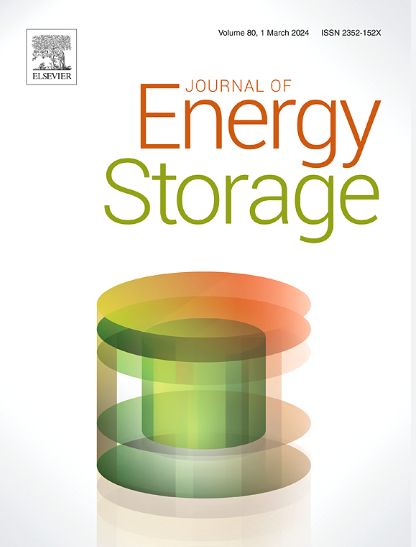大尺寸电池在空旷空间和密闭巷道中热失控引发火灾行为的对比研究
IF 8.9
2区 工程技术
Q1 ENERGY & FUELS
引用次数: 0
摘要
以往的研究大多集中在小尺寸锂离子电池在空旷空间热失控引发的火灾行为上,而对大尺寸锂离子电池在空旷空间和密闭隧道中火灾行为的比较研究很少。采用50ah、72ah、86ah容量的磷酸铁锂大容量电池,在开放空间和密闭隧道中进行了一系列实验。比较了大尺寸电池在不同空间形态下的火灾行为,分析了电池火灾不同阶段密闭巷道内的温度分布。无论是露天还是密闭隧道,大规格磷酸铁锂电池热失控引起的火灾行为均表现为火焰形状、质量、火焰长度和表面温度变化的四个典型阶段,而密闭隧道则表现为点火后爆轰的阶段②。开放空间的质量损失率、放热率、火焰长度、表面温度和火焰温度均大于密闭隧道的相应值,且由于火焰羽流机制不同,阶段②的这些参数均大于阶段③。②~④阶段的持续时间明显短于密闭隧道。此外,根据火焰形态建立了简化的辐射热流密度模型。密闭隧道内的辐射热通量减弱,且阶段②大于阶段③。此外,还提出了限定巷道中大型磷酸铁锂电池火灾的②~③阶段最高温度和纵向顶棚温度的修正模型。本文章由计算机程序翻译,如有差异,请以英文原文为准。
Comparative investigations on fire behaviors induced by the thermal runaway of large-format batteries in open space and confined tunnel
Most previous work mainly focused on the fire behaviors induced by thermal runaway of small format lithium-ion batteries in open space, but very few studies presented the comparison of fire behaviors for large format batteries in open space and confined tunnel. A series of experiments were conducted using large-format lithium iron phosphate batteries with different capacities (50 Ah, 72 Ah, 86 Ah) in open space and confined tunnel. The fire behaviors of large format batteries under different space forms are compared and the temperature distribution in the confined tunnel for different stages of battery fires is analyzed. Whether for open space or confined tunnel, the fire behavior induced by thermal runaway of large-format lithium iron phosphate batteries exhibits four typical stages with external manifestations of the changes in flame shape, mass, flame length and surface temperature, but the detonation is observed after ignition in stage ② for confined tunnel. The mass loss rate, heat release rate, flame length, surface temperature and flame temperature for open space are larger than the corresponding values for confined tunnel, and these parameters in stage ② are greater than that in stage ③ due to the different fire plume mechanisms. However, the durations of stages ②–④ for open space are significantly shorter compared to those for confined tunnel. Moreover, a simplified model of radiative heat flux is established by the flame morphology. The radiative heat flux is weakened in the confined tunnel, and it is larger in stage ② than that in stage ③. Besides, the modified models for the maximum and longitudinal ceiling temperature are proposed for stages ②–③ for large-format lithium iron phosphate battery fires in the confined tunnel.
求助全文
通过发布文献求助,成功后即可免费获取论文全文。
去求助
来源期刊

Journal of energy storage
Energy-Renewable Energy, Sustainability and the Environment
CiteScore
11.80
自引率
24.50%
发文量
2262
审稿时长
69 days
期刊介绍:
Journal of energy storage focusses on all aspects of energy storage, in particular systems integration, electric grid integration, modelling and analysis, novel energy storage technologies, sizing and management strategies, business models for operation of storage systems and energy storage developments worldwide.
 求助内容:
求助内容: 应助结果提醒方式:
应助结果提醒方式:


